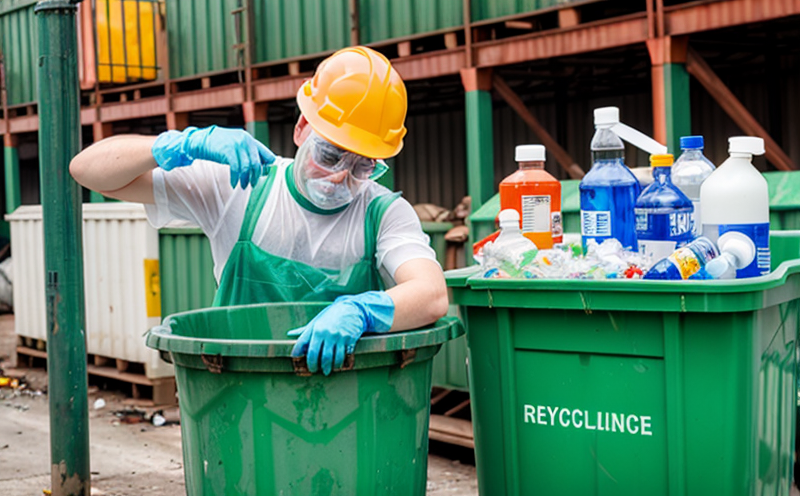ASTM D4972 pH Testing of Waste and Recycled Soils
The ASTM D4972 standard provides a method specifically designed for the determination of the pH value of waste and recycled soils. This test is crucial in environmental compliance, risk assessment, and quality assurance within the chemical testing sector. Understanding the importance of this test requires an overview of its application, methodology, and significance.
The pH level is one of the most critical parameters that influence soil behavior, particularly in waste management and recycling processes. Waste and recycled soils often contain a wide range of materials with varying pH levels, which can impact their handling, treatment methods, and ultimate disposal or reuse. Accurate determination of pH ensures compliance with regulatory standards and enhances decision-making regarding further processing steps.
The test method outlined in ASTM D4972 is straightforward but precise. It specifies the collection and preparation of soil samples from waste and recycled materials for pH measurement using a calibrated pH meter. The standard emphasizes the importance of proper sample handling to avoid contamination or alteration of the sample's original characteristics.
Sampling should be conducted according to best practices, ensuring that representative samples are taken across different layers and depths within the waste material. Once collected, these samples must be stored in appropriate containers under controlled conditions until analysis can be performed.
Using a calibrated pH meter, the actual measurement of pH is made by submerging the electrode into a prepared soil paste or slurry. The consistency of this mixture should be maintained at a specified water-to-soil ratio to ensure accurate readings. After calibration and preparation, the pH value can be obtained within minutes.
The results from ASTM D4972 play a pivotal role in various stages of waste management and recycling processes:
- Identifying suitable candidates for reuse or beneficial use;
- Evaluating potential risks associated with specific materials;
- Ensuring compliance with local, state, and federal regulations;
- Supporting R&D efforts in developing new treatment methods.
In summary, ASTM D4972 pH testing is not just a procedural step but an essential tool for ensuring environmental safety and regulatory adherence. By providing accurate pH values, this test helps stakeholders make informed decisions about waste and recycled soils throughout the entire lifecycle of their management.
Applied Standards
| Standard | Description |
|---|---|
| ASTM D4972-18 | This standard provides a method for determining the pH value of waste and recycled soils. It is essential for ensuring accurate measurement under controlled conditions. |
| ISO 10392:2009 | An international standard that specifies the procedure for the determination of pH in soil solutions, which can be referenced to ensure consistency with other relevant testing methods. |
The application of these standards ensures that all tests are conducted under consistent and validated protocols. This consistency is crucial when comparing results across different laboratories or over time within a single facility.
Scope and Methodology
The scope of ASTM D4972 pH testing encompasses the determination of pH in waste and recycled soils, which includes both solid materials and slurries. The methodology involves several key steps:
- Sampling: Collecting representative samples from various layers within the waste material.
- Sieving: Passing the collected soil through appropriate sieves to remove oversized particles that could affect measurement accuracy.
- Soil Paste Preparation: Mixing the ground soil with distilled water in a ratio of 1:2.5 (wet weight). This step is critical for achieving an accurate pH reading.
- Measurement: Using a calibrated pH meter to measure the pH value of the prepared soil paste or slurry.
The accuracy and precision of these steps are directly linked to the reliability of the final results. Proper calibration of equipment, consistent sample preparation, and adherence to specified conditions during measurement are paramount in obtaining accurate pH values.
Understanding each step ensures that laboratories conducting this test can adhere strictly to ASTM D4972 guidelines, thereby ensuring consistent and reliable outcomes across different testing facilities.
Why Choose This Test
- Regulatory Compliance: Ensures adherence to environmental regulations concerning waste management and recycling.
- Risk Assessment: Identifies potential risks associated with specific waste materials before processing or disposal.
- Quality Assurance: Guarantees the quality of recycled soils used in various applications, ensuring they meet specified pH criteria.
- Data Accuracy: Provides precise and accurate pH values that are critical for informed decision-making.
The importance of ASTM D4972 pH testing extends beyond compliance; it also supports sustainable practices by enabling the safe reuse or beneficial use of waste materials. This method helps in minimizing environmental impacts while promoting recycling efforts.





